Please excuse the nerdy headline—I’ve been on a real “Lord of the Rings” kick recently—but if I can borrow some of Mr. Tolkien’s flare for the dramatic, I will say that there really is one social media metric out there should be monitored more closely than the rest.
Before I get into which stat is the most important and spoil the whole surprise—as if you couldn’t just scroll to the bottom—I want to discuss some of the other metrics that still play a crucial role in social media marketing, and why they’re still extremely important for you to keep tabs on.
5 Important Social Media Stats You Should Monitor
1. Post Count
Post count refers to the amount of social media posts that you create across all of your social networks and profiles. It’s important to always post a steady amount of content to keep all of your social followers engaged with your brand. It can help establish you as a thought leader, and it can help drive traffic to your site if you provide links.
However, post count isn’t the most important metric because there really can be no direct correlation between an increase in posting frequency and an increase in impressions, clicks, customers and revenue.
In fact, there’s a point where if you’re posting too often, your fans may choose to unsubscribe from your social media updates altogether. Remember that just because followers opted-in to your social content doesn’t mean they want to be pitched on a regular basis.
2. Follower Count
This is the number of people who follow your brand on the various social networks, and in the early days of social media marketing this was probably considered the most important metric. Organic social media reach was near 100%, which meant that every social post that you created was seen by almost all of your followers. So the more followers you had, the more free advertising you could get.
Unfortunately for the early adopters, in recent years the social media networks have started to cut down the amount free social reach each brand has. This article from Convince & Convert shows the trend in organic reach decline.

Even though the amount of followers a brand has can’t directly tie to success through reach, it is still a great indication of how your content performs. If you continue to create great content that gets shared, or if you continue to grow as a popular product or service, it would make sense that the number of followers that brand has would increase.
3. Reach
Reach refers to the amount of people who saw your social media posts and is a fairly critical metric when it comes to social media marketing. One of the main objectives for social should be to increase your branding and awareness–which is most effectively done by increasing your reach. It’s important to work towards increasing your reach, and there are some great ways to do it:
- Get social media shares
- Utilize relevant hashtags
- Try real-time marketing
- Look to past successful content
The downside is that increasing your impressions doesn’t necessarily mean you’re increasing the positive sentiment around your brand. For instance, you could post a ton of content to your page that you know will go viral online—gaining tons of impressions in the process—but if that content isn’t actually relevant to your company, it doesn’t really help your cause.
4. Clicks
Clicks are the people who actually see your posts and click through from to your website to view your content. Clicks are important because you need to get users to your page if you’re going to convert them to become a customer. If one of your main goals for social media is to drive traffic to your site, this is one of the most important metrics you can track. One way to increase the clicks on your content is to look through your social media analytics—you can do this with a social media analytics tool like Sprout Social—to see which type of content it is that your fans are likely to click.
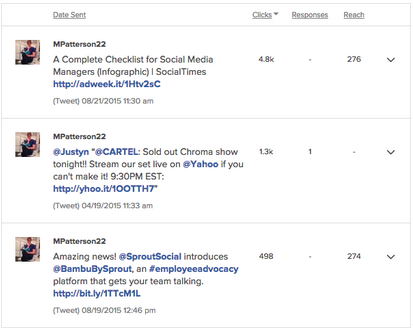
The reason clicks isn’t the top metric is because it doesn’t necessarily tie into leads, sales and revenue. Although it’s great to get traffic to your site, there is no guarantee that those people will convert.
5. Shares
Social shares are the actions your followers use to promote your content out to their own social circles, such as Retweets and Pins. Shares show that someone enjoys the content you create so much that they’re willing to put their name on it and promote it to their social channels. Shares also lead to an increase in your impressions and can fuel clicks through to your website.
The downside to getting shares is that, similar to clicks, they don’t necessarily lead to completion of any goals beyond fueling branding/awareness.
One Social Media Metric to Rule Them All
Without further ado, the one metric that should be the most important to your social media management and marketing strategies.
Engagement
Even though social media can play a big part in boosting awareness, sourcing new leads and generating revenue, it should first and foremost be considered a channel for providing online customer service. And the best way to do that is to engage with your fans and followers. More than ever, your customers are using social media as a way to interact with your brand. In fact, the past year has seen the number of social messages sent to brands that require response increase by 110%.
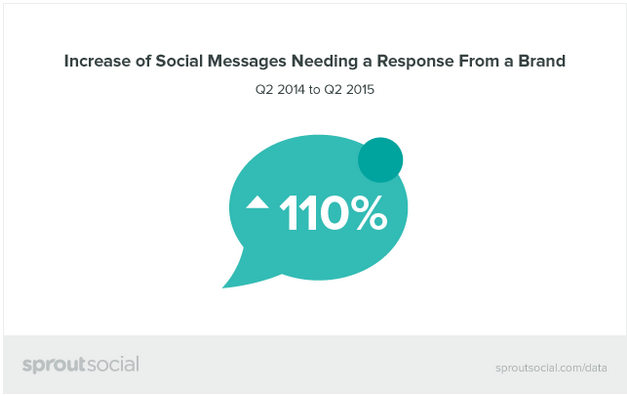
However, seven in eight of these messages sent to brands go completely unanswered within the first 72 hours.This is just bad for business, as 72% of people who complain on Twitter expect a response within an hour.
That’s why engagement metrics—including speed and rate—are the most important thing to consider when analyzing social media.
Engagement Rate
Engagement rate refers to the percentage of messages you respond to that require response. Though you should always be aiming for a 100% engagement rate, the standards vary across each industry.
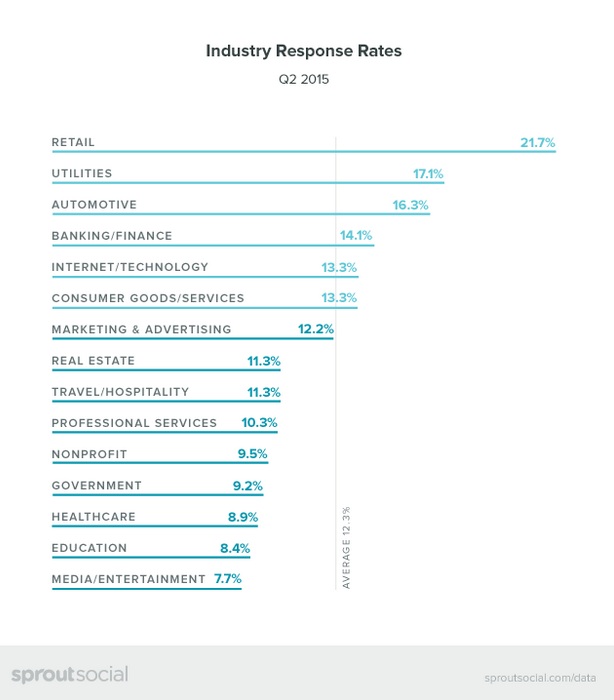
But the key here is to be better than your industry average. One amazing example is Royal Dutch Airlines which has surpassed its industry average of 11.3% by leaps and bounds.
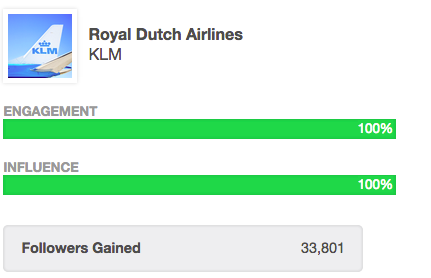
Engagement Time
Engagement rate refers to the speed with which you are replying to those messages sent to your brand that require response, and is important since users expect quick responses on social. Again, the average response rate varies by industry.
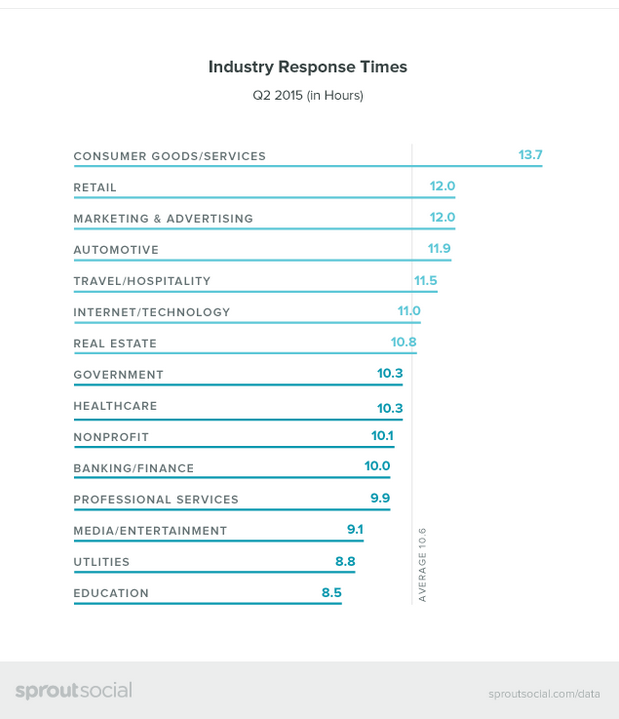
But if 73% of social users expects a response within an hour, every single industry could benefit from better social engagement. To continue with the Royal Dutch Airlines example, the airline constantly updates their Twitter header image to show just how long one should anticipate waiting for a response–and it almost always beats this benchmark.
Conclusion
There are so many amazing things that businesses can accomplish on social media channels, and each of those goals comes with their own important metrics to monitor. However, social media should be a customer service channel before anything else. That’s why keep track of–and improving–your social engagement rates should be your top priority in social media management.
If you’re interested in finding out your own engagement rates—and need a tool that can help you improve them—check out Sprout Social. For more information on social media platforms check out the post that Visually created with the a list of the top 16 tools.
Michael Patterson leads co-marketing efforts at Sprout Social, a social media management and engagement platform for business. His insights are regularly featured on Sprout Social’s Insights blog, Social Media Examiner and Adweek’s SocialTimes. When he isn’t pouring over content or researching social strategies, he can be found exploring Chicago’s unique neighborhoods and breweries.
The post One Social Media Metric to Rule Them All appeared first on Visually Blog.
from Visually Blog
http://blog.visual.ly/one-social-media-metric-rule/
No comments:
Post a Comment